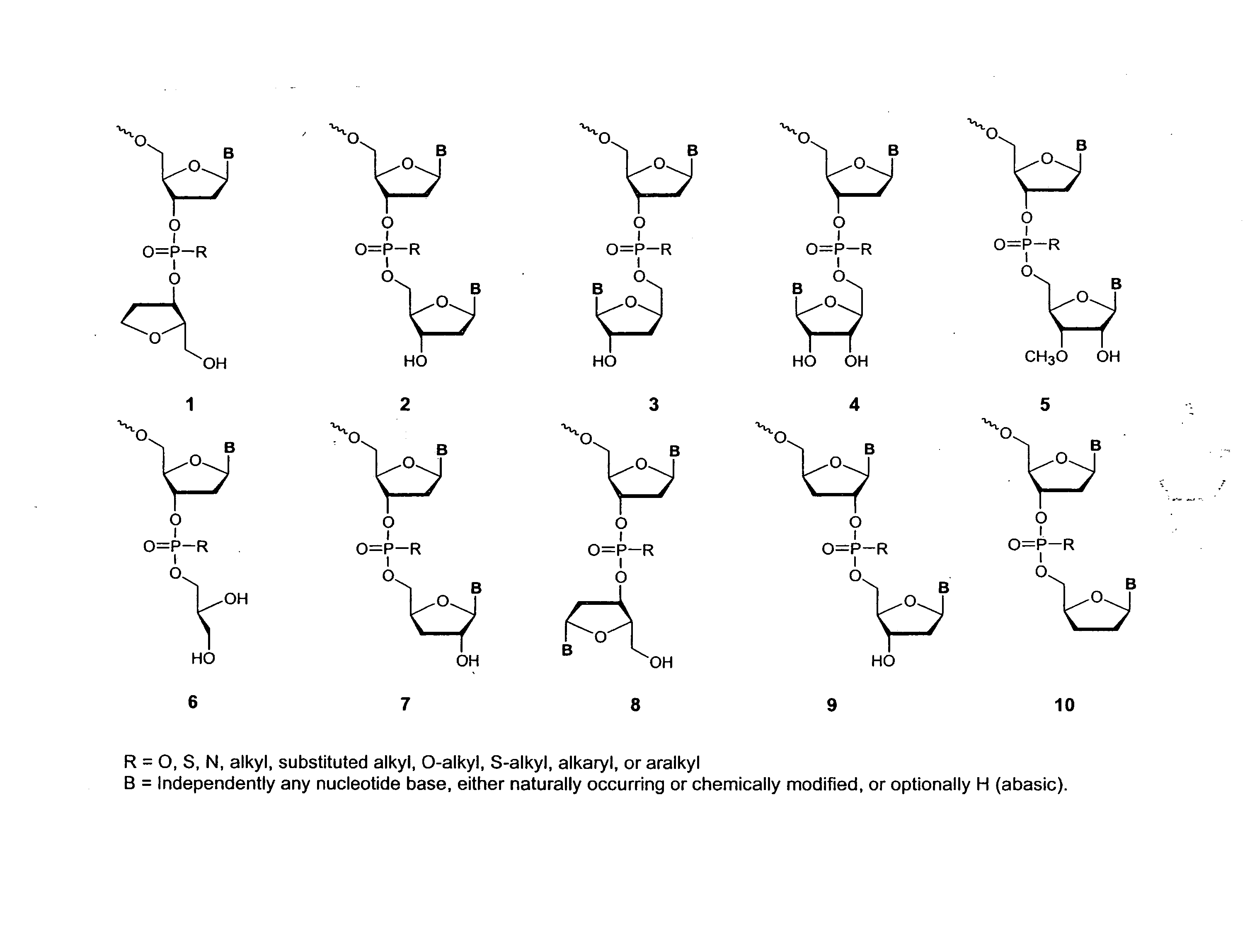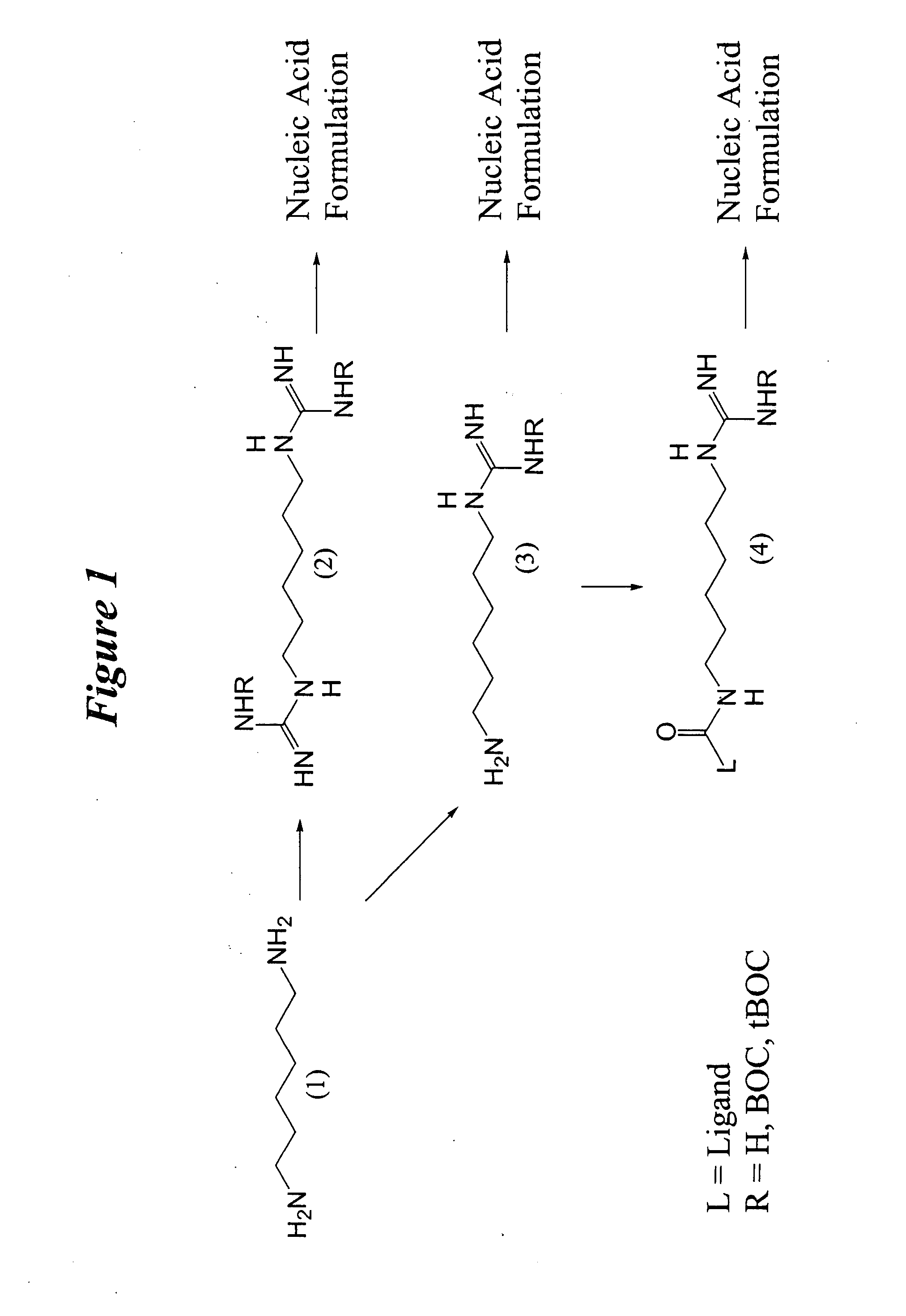Polycationic compositions for cellular delivery of polynucleotides
a polynucleotide and polymer technology, applied in the direction of transferases, peptide/protein ingredients, ligases, etc., can solve the problems of high toxicity to normal tissues, inability to carry many compounds into living cells, and inability to carry many compounds at the same time, so as to prevent interaction with receptors
- Summary
- Abstract
- Description
- Claims
- Application Information
AI Technical Summary
Benefits of technology
Problems solved by technology
Method used
Image
Examples
example 1
Synthesis of Cationic Polymers
Generalized Synthesis of bis-guanidinium compounds; e.g. compounds (2), (6), (10), (14), (18), (24) from FIGS. 1-6.
[0328] To a stirred solution of diamine (1), (5), (9), (13), or (17) or triamine (21) in 1,2-dicholoroethane or other suitable solvent is added N,N′-bis(tert-butoxycarbonyl)-1H-pyrazole-1-carboxamidine (2.0-2.2 equivalents to diamine / triamine). After stirring at room temperature for 24 h, the reaction mixture is concentrated on a rotary evaporator. The resulting solid is applied to a silica gel column and a suitable gradient, such as hexanes / dichloromethane / triethylamine (e.g. 80:15:5) is applied, appropriate fractions are collected and evaporated to yield N,N′-bis(tert-butoxycarbonyl) protected bis-guanidinium intermediates. These compounds are then suspended in anhydrous methanol a solution of 4.0 M hydrogen chloride in 1,4-dioxane is added and the resulting gas is liberated from the reaction. The resulting solution is stirred at 40° ...
example 2
Formulation of Polycationic Complexes with siNA
Preparation of Cationic Amine Complexes of siNA.
[0334] A siNA molecule, such as a siNA duplex, is complexed with a cationic compound based upon charge ratio. The complex can be formulated with different charge ratios by using equivalents of nucleic acid to cation to generate a formulation with a net positive charge (e.g. excess cation to nucleic acid), a neutral charge, or a net negative charge (e.g. excess nucleic acid to cation). The cation can be titrated into a solution of nucleic acid or the nucleic acid can be titrated into a solution of the cationic compound. In a non-limiting example, a siNA duplex comprising sequence (sense strand =5′-fluorescein-ugugcacuucgcuucaccuuu-3′ where a, g, c and u are all ribonucleotides (SEQ ID No: 1) / antisense strand=5′-AGGuGAAGcGAAGuGcAcATsT wherein A and G are 2′-O-methyl nucleotides and u and c are 2′-deoxy-2′-fluoro nucleotides (SEQ ID No: 2)) was obtained in HPLC purified form and dissolved ...
example 3
Formulation of Lipoplex Complexes with Nucleic Acids
Preparation of Lipoplex with Polycationic Amines and Neutral Lipid:
[0337] The cationic compounds of the invention (e.g. compounds having any of Formulae 1-60) can be formulated into a lipoplex comprising a cationic component, a lipid component, and a biologically active molecule component (e.g. siNA). The formation of a lipoplex can lead to improved pharmacokinetic properties such as increased half life and increased serum stability of biologically active molecules to be delivered to relevant cells and tissues. In a non-limiting example, a standard neutral phosphatidylethanolamine lipid was purchased from Avanti Polar Lipids as a 10 mg / mL solution in chloroform (Avanti Cat. No. 850402, 1,2-Diphytanoyl-sn-Glycero-3-Phosphoethanolamine, F. W. 804.19). A cationic amine conjugated to cholesterol via a tetraethylene glycol ether linkage (compound 36, FIG. 9) was prepared as described herein. 550 uL of the Cholesterol conjugate at 20 ...
PUM
| Property | Measurement | Unit |
|---|---|---|
| molecular weight | aaaaa | aaaaa |
| pH | aaaaa | aaaaa |
| diameter | aaaaa | aaaaa |
Abstract
Description
Claims
Application Information
 Login to View More
Login to View More - R&D
- Intellectual Property
- Life Sciences
- Materials
- Tech Scout
- Unparalleled Data Quality
- Higher Quality Content
- 60% Fewer Hallucinations
Browse by: Latest US Patents, China's latest patents, Technical Efficacy Thesaurus, Application Domain, Technology Topic, Popular Technical Reports.
© 2025 PatSnap. All rights reserved.Legal|Privacy policy|Modern Slavery Act Transparency Statement|Sitemap|About US| Contact US: help@patsnap.com



